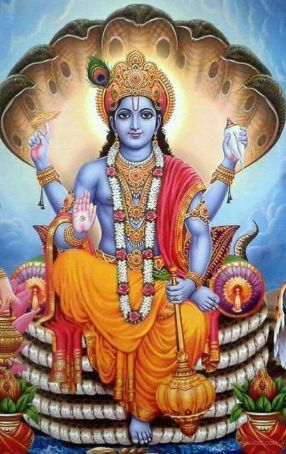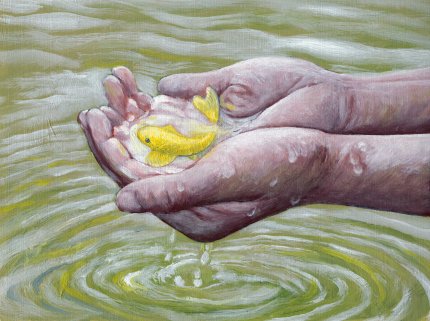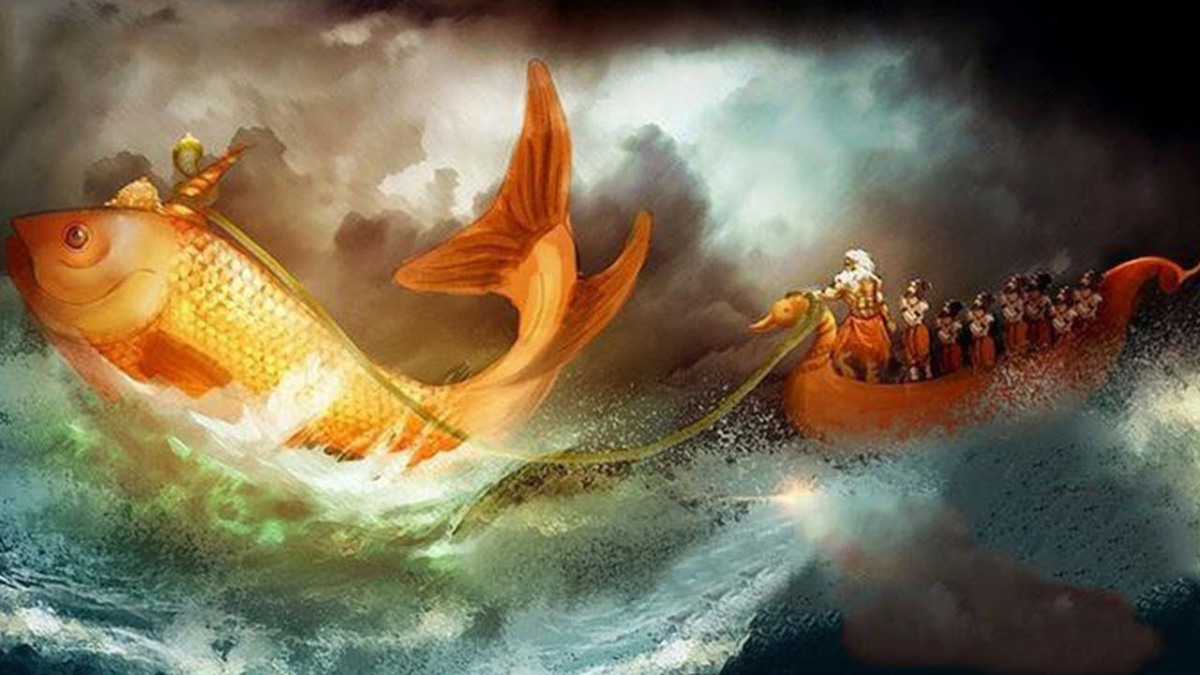Let’s talk about Hindu mythology and the story of the first of Vishnu’s 10 incarnations or Dasavatara, the Matsya or the fish, today. This is part one of a two-part series on the Matsyavatara.
In this myth, unlike in Greek mythology, I cannot just launch into the main story because it is far too complicated and far too confusing if you are not aware of the background in which it is set. This series is an attempt to simplify the story found in the Matsya Purana, and among the oldest stories in the eighteen major Puranas in Hindu literature. So without further ado, let us begin with somewhat of a prologue and set the scene for the story, hope you’ll enjoy it.
In Hindu mythology, time is considered cyclical and is divided into eras or Yugas. Each Yuga is supposed to be approximately 4320 million human years and equivalent to a day in the life of the Lord of Creation, Brahma. When evil overrules the good, there is Pralay or an apocalypse and a new Yuga begins afresh. Also at the end of every Yuga, Brahma goes to sleep, after a whole day of creation having tired him out. (Cmon, he earned that nap, let him have it, its been literal million years.) Brahma’s knowledge of creation came from the Vedas, which are the oldest religious scriptures of Hinduism and which he kept on his person and will be very important in this story.

Humans were becoming immoral day by day and the Satya Yuga was close to ending. (This immorality is by the standards of an era when people were the most honest they ever were or will be. So, you know. Go figure.) Right on schedule, Brahma decided it was time for his ‘daily’ slumber and as he started to close his eyes and go to sleep, he yawned and the horse-headed demon Hayagriva came out of his nose, stole the Vedas and went and hid at the bottom of the ocean, thinking that no one would find him there. (Can you blame him? 95 per cent of the Earth’s oceans are still undiscovered, to this day. It was a good plan, you know, apart from the thieving and stuff.) Vishnu, the God of Preservation was worried by this development because if the Vedas were stolen their knowledge could not be used in the next Yuga which was about to begin. Since it was his job to ensure the preservation(of knowledge) for the next era, it was time for Vishnu to take his first incarnation and come to Earth and that is where our story, truly, officially, begins. (Finally.)

On Earth, there lived a man named Manu, who was very pious and devoted to Vishnu. He used to pray and perform penance to fulfil his lifelong dream of seeing Vishnu with his own eyes. One day, as he began his prayers at the river and took some water from it in his hands and was about to pour it back, he noticed a tiny fish in his hands. The fish was begging him to not put it back in the water as other bigger fish might eat him. (This is very ancient times, he can speak fish, its not a big deal) He decided to help the fish and took it to his house and put it in a small pot. When the fish outgrew the pot, he put it in a bigger one. Soon, it outgrew that pot as well and went on to outgrow every other pot in Manu’s home. So, he put the fish in the river. Then a bigger river. Then an even bigger one. Soon, this fish outgrew all the rivers and Manu put it in the ocean.

When put in the ocean, the fish grew to the size of the ocean, a horn grew out of its head and it revealed itself to be Vishnu. Manu bowed in reverence and was overwhelmed to see his dream fulfilled. He asked him what the Lord wanted of him. Vishnu then told Manu that the Yuga was going to end in 7 days; there would be a great flood, and all life on earth would perish. He instructed him to build a big ship, take seeds of all the plants, male and female of all species of all the animals, and the Seven Sages on it. (The Seven Sages or Saptarishi are a big deal in Hindu mythology. They are considered the patriarchs of the Vedic religion) He also told him to bring the god of the snakes, Vasuki on the ship. (Did it remind you of a very famous story yet? If not, ‘Ill give you a hint. Think biblical.)![]()
Having given his instructions and completing one half of its mission on Earth the Matsya Avatar,a.k.a Lord Vishnu set off to the bottom of the ocean to find the demon Hayagriva and bring the Vedas back. That tale though is for the next part.
To be continued.
THIS POST’S QUESTION: This tale begins with the idea that time is cyclical. Do you agree or disagree? Let me know what you think about it,I’d love to hear from you!

12 replies on “De-myth-ify: Matsyavatara (Part One)”
[…] For the previous post in this series, click here. […]
LikeLike
So true. I appreciate you blogging this.
LikeLiked by 2 people
Thank you,that means a lot!
LikeLiked by 2 people
The pleasure is all mine
LikeLiked by 2 people
Very nice post 👍😁
LikeLiked by 1 person
Thank you! ❤️
LikeLike
Most welcome 🤗🙏🙏🌹
LikeLiked by 1 person
Refreshing to read articles based on the Vedas. All of us should write more such articles. The world needs exactly this. Thanks for this.
LikeLiked by 1 person
I agree! Thank you for your kind words!
LikeLiked by 1 person
Great insightful post & glad to read such posts. Keep up doing great work.📝👌👍
LikeLiked by 1 person
Thank you!
LikeLike
[…] For the previous series of posts on the first of the Dasavatara, Matsya or the fish, click here. […]
LikeLike